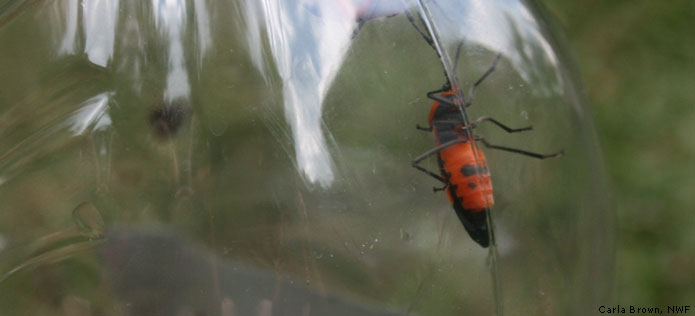
Recycle a plastic bottle into a temporary home for bugs so you can observe them, then set them free.
What You Need
- Large transparent plastic bottle that you can cut into – keep the cap
- Heavy duty tape, such as duct tape
- Insect identification book (optional)
- Knife or kitchen scissors
- Newspaper
- Large flat soft paint brush (for sweeping bugs into bug jug)
- Screen – mesh, such as you find on a patio door, or fabric such as a sheer curtain – approximate 6 inches by 6 inches
- Sketchbook, pencils and crayons (optional)
What You Do
- Cut a window into the side of the bottle.
The window needs to be about four inches by four inches – big enough so you can easily sweep a bug into it.
We found it helpful to choose a bottle that was flat on one side, such as a juice container, to make the bottle steady while we were cutting it.
- Cut the screen to the right size.
Lay the piece of screen over your window and cut it so there is at least an inch all around. Make sure it covers the whole window or your bugs will get out.
- Tape the screen in place.
Tape one side firmly, but the other three loosely. You need to open the screen to put your bugs inside.
- Put some natural items in your jug.
Line the bottom with some leaves and rocks to provide habitat for your bugs. - Catch some bugs.
Find some plants that have bugs on them. We found lots of milkweed bugs on our milkweed.
Put a piece of newspaper on the ground below the bug in case they fall as you are catching them. This gives you a second chance to scoop them up.
- Brush the bug into the open window of the bug jug.
It might help to have two people for this task – one to keep the screen open and hold the jug, one to gently brush in the bug with your paint brush.
- Tape the window shut and observe your bug.
What does it do in there? Does it crawl upward, or in all directions? Does it try to hide under the leaves? If you put two kinds of bugs inside the bug jug, does one try to get the other? Do any of the bugs nibble the plants?
You could use an insect identification book to identify your bug. You could draw a picture of your bug in a sketch pad.
Observe the bug for a while in a shady spot so it doesn’t get too hot in your jug.
When you are done, set your bug free.
(The original idea for this activity was created by Jennifer Bové.)
